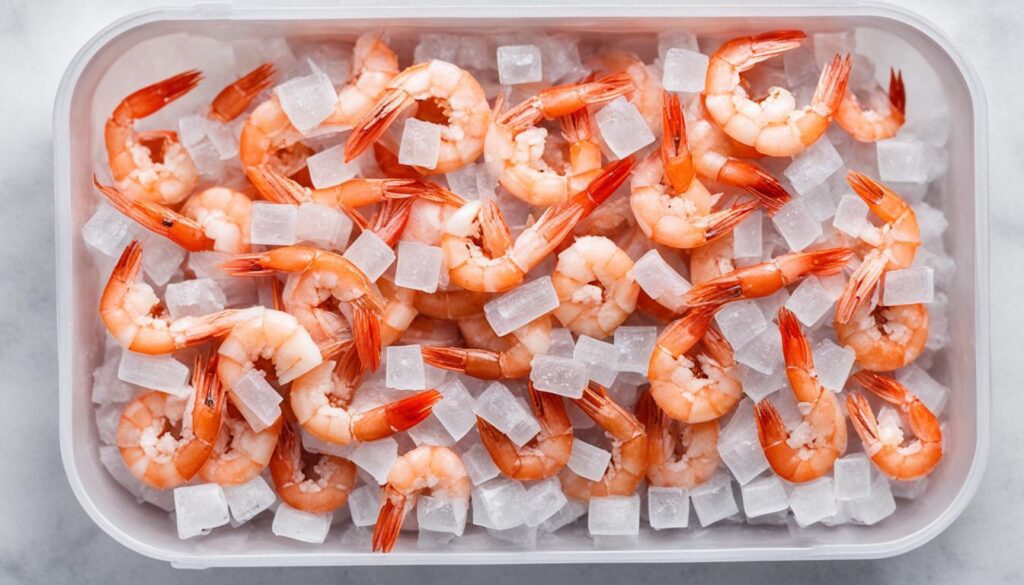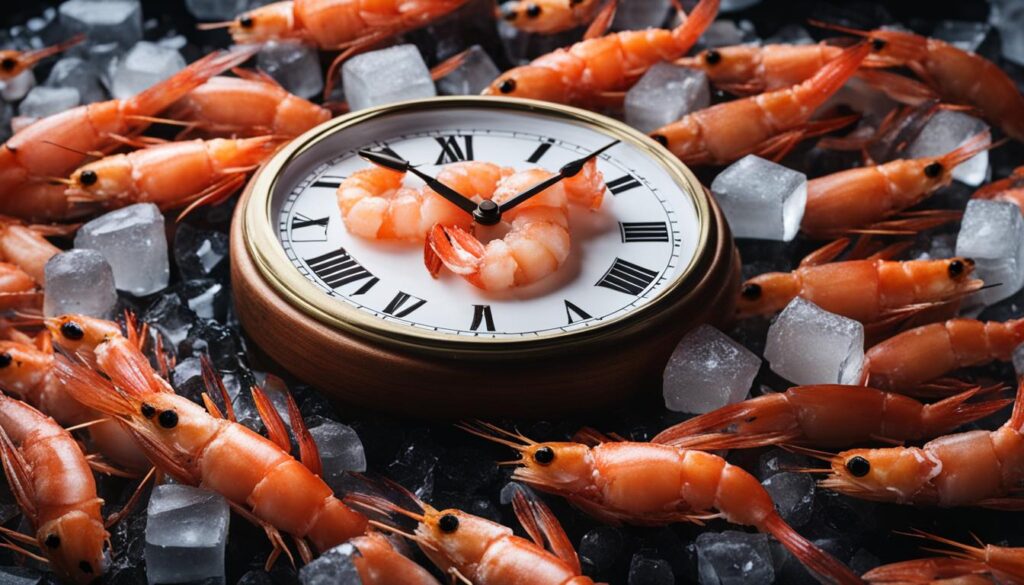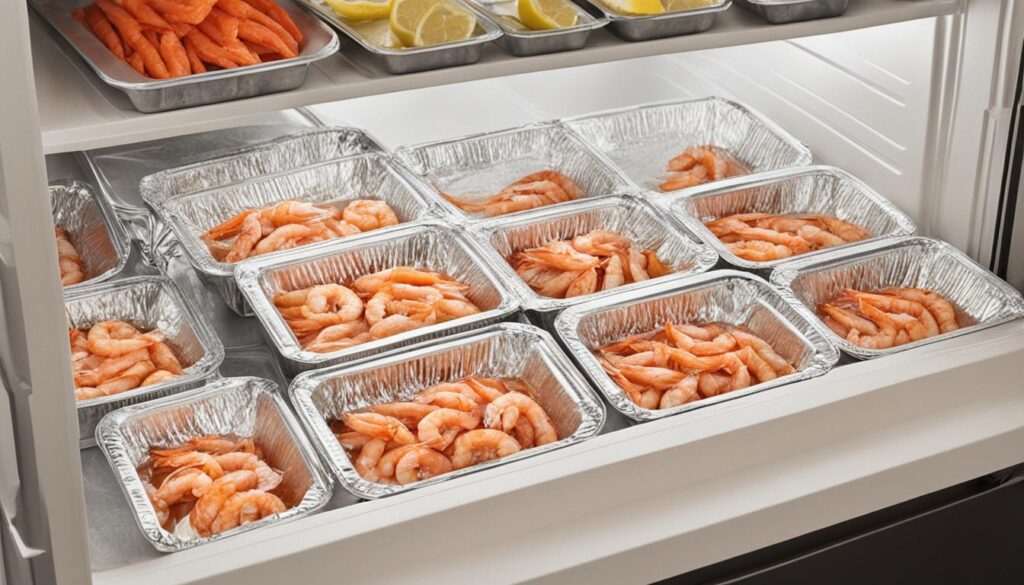If you’re wondering about the freezer life of shrimp and the best practices for storing them, you’ve come to the right place. Shrimp, whether raw or cooked, can be a delicious addition to your meals. But how long can you safely keep them in the freezer?
When it comes to raw shrimp, they can last for up to one year in the freezer. However, for the best taste and texture, it is recommended to use them within three months. This ensures that you enjoy the optimum quality when you eventually cook and consume them.
For cooked shrimp, the freezer storage time is slightly shorter. You can keep cooked shrimp frozen for up to three months. Proper storage is key to preserving their taste and freshness during this time.
By following the right guidelines and taking the necessary precautions, you can make the most of your shrimp storage in the freezer. In the upcoming sections, we will discuss the best practices for freezing shrimp, proper thawing methods, signs of spoiled shrimp to look out for, and much more. So, let’s dive in and learn how to extend the shelf life of frozen shrimp.
Proper Storage of Shrimp in the Freezer
Preserving shrimp in the freezer is essential to maintain its freshness and quality. Whether you have raw or cooked shrimp, following the best practices for freezing shrimp will ensure that you can enjoy it for an extended period.
For raw shrimp, it is advisable to store them in their original packaging on the bottom shelf of the refrigerator. This helps minimize the risk of cross-contamination in case any liquid leaks from the package. The original packaging is designed to keep the shrimp fresh, so it’s best to use it for storage. If the packaging is damaged or leaks, transfer the shrimp to an airtight container or wrap it tightly in plastic wrap before freezing.
When it comes to cooked shrimp, it is important to place them in an airtight container in the refrigerator. This will prevent them from drying out and absorbing odors from other foods. Labeling and dating the containers when freezing shrimp is crucial to keep track of their storage time. It will help you determine when to use them before they start to deteriorate in quality.
It’s worth noting that maintaining the proper temperature in your freezer is crucial. Make sure it is set to 0°F (-18°C) or below to ensure the safe storage of your shrimp.
To summarize, here are the best practices for freezing shrimp:
Best Practices for Freezing Shrimp:
Type of Shrimp Storage Method Raw Shrimp Keep in the original packaging on the bottom shelf of the refrigerator, or transfer to an airtight container if necessary. Cooked Shrimp Place in an airtight container in the refrigerator. Freezer Temperature Maintain the freezer temperature at 0°F (-18°C) or below.
Properly storing shrimp in the freezer will help preserve its taste and texture, allowing you to enjoy delicious shrimp dishes whenever you desire.

Why Shrimp Has a Short Shelf Life in the Fridge
Shrimp spoils more quickly than other meat or seafood due to living conditions. Shrimp and other shellfish live underwater in colder temperatures. The bacteria in their systems have acclimated to growing in these colder conditions. When placed in the refrigerator, which is a similar temperature to where they lived, the bacteria in shrimp can grow rapidly. This is why shrimp has a shorter shelf life in the fridge compared to land animals like cows and chickens.
Understanding the Science Behind Shrimp Spoilage
Shrimp and other seafood thrive in colder oceanic habitats, where the bacteria they carry have adapted to these frigid temperatures. When shrimp are caught and brought on land, their bodies are no longer in the chilly waters they once inhabited. Instead, they are exposed to the temperature of the refrigerator, which falls within the same range.
The bacteria that naturally reside on shrimp can now flourish in the refrigerator’s similar climate, accelerating their growth and causing the rapid spoilage of shrimp. Unlike land animals, such as cows and chickens, whose internal bacteria are accustomed to warmer environments, the bacterial growth on shrimp is optimized for colder conditions. As a result, the shelf life of shrimp in the fridge is significantly shorter.
The Effects of Bacterial Growth on Shrimp
When bacteria multiply on shrimp, it leads to changes in texture, color, and odor, indicating the shrimp is no longer safe to consume. The abundant bacterial growth causes the shrimp to deteriorate at a faster rate than other meats or seafood, making it imperative to pay attention to proper storage and handling.
In addition to bacteria, enzymes present in shrimp can also contribute to its spoilage. These enzymes play a role in the natural breakdown of shrimp tissue and can hasten its deterioration if not properly controlled through freezing or cooking.

| Factors Affecting Shrimp Shelf Life | Impact on Shelf Life |
|---|---|
| Temperature Fluctuations | Promotes bacterial growth and enzymatic activity, accelerating spoilage |
| Inadequate Packaging | Exposes shrimp to air and moisture, leading to faster deterioration |
| Improper Handling and Cross-Contamination | Introduces additional bacteria to shrimp, increasing spoilage |
| Extended Storage Time | Allows bacteria to proliferate further, reducing quality and safety |
Correctly understanding the short shelf life of shrimp in the fridge empowers you to take the necessary steps to ensure its freshness and prevent waste. By adopting proper storage practices and being mindful of temperature control, you can enjoy high-quality shrimp without compromising safety and taste.
Reheating Shrimp and Storage Tips
Reheating shrimp can be a challenge as it can easily become overcooked and rubbery. To avoid this, there are a few tips you can follow:
If you’re reheating shrimp:
- Use the same method it was originally cooked with, such as sautéing, grilling, or steaming. This helps to retain the texture and flavor of the shrimp.
- Use a lower temperature than the original cooking temperature to prevent overcooking. This allows the shrimp to heat through without becoming tough or rubbery.
If you’re mixing shrimp with other leftovers:
If you’re combining shrimp with dishes like pasta or rice, it’s best to heat the starch component first before adding in the cold shrimp. This helps to remove some of the chill and ensures that the shrimp heats evenly with the rest of the dish.
Alternatively, you can let the cooked shrimp sit out at room temperature for about 15 minutes before reheating. This allows the shrimp to come closer to room temperature, reducing the cooking time and the risk of overcooking.
For longer-term storage of cooked shrimp, freezing is a great option. Here’s how you can do it:
- Place the cooked shrimp in a freezer-safe bag or container. Squeezing out any excess air before sealing the bag helps prevent freezer burn.
- Label the bag with the date of freezing to keep track of its storage time.
- Store the bag in the freezer, where the shrimp can last for up to three months, maintaining its taste and texture.
By following these reheating and storage tips, you can enjoy delicious shrimp without compromising its quality.
Reheating Shrimp Methods Comparison
| Reheating Method | Advantages | Disadvantages |
|---|---|---|
| Sautéing | Quick and provides a nice sear on the shrimp. | Requires constant stirring to prevent overcooking. |
| Grilling | Retains a smoky flavor and adds charred marks. | May require preheating the grill and longer cooking time. |
| Steaming | Gentle cooking method that helps maintain tenderness. | Requires special equipment like a steamer basket. |

Shelf Life of Frozen Shrimp
When it comes to frozen shrimp, understanding its shelf life is essential to maintain its quality and taste. Raw shrimp can be safely stored in the freezer for up to one year, but for the best flavor and texture, it is recommended to consume them within three months. On the other hand, cooked shrimp, when properly frozen, can be stored for up to three months.
To ensure easy identification and tracking of the storage time, it is advisable to label the bags with the date of freezing. By doing so, you can keep track of how long the shrimp has been in the freezer and make informed decisions about its usage.
| Shrimp Type | Freezer Shelf Life |
|---|---|
| Raw Shrimp | Up to 1 year (best within 3 months) |
| Cooked Shrimp | Up to 3 months |
It is crucial to maintain a freezer temperature below 32°F (-0°C) to ensure the quality and safety of the shrimp during its storage. Freezing at lower temperatures helps preserve the freshness and minimize the risk of bacterial growth, ensuring that your shrimp remains delicious when you’re ready to use it.
Thawing Frozen Shrimp
When it comes to enjoying the deliciousness of shrimp, proper thawing methods are essential. Thawing frozen shrimp can be done using two main techniques: refrigeration and cold water. Let’s explore both methods in detail.
Refrigeration Method
Thawing shrimp in the refrigerator is the safest and most convenient method. Follow these steps:
- Place the frozen shrimp in a bowl or container to catch any drips.
- Put the container in the refrigerator and allow the shrimp to thaw overnight.
This slow thawing process guarantees a gentle temperature change, ensuring that the shrimp remains safe to consume while retaining its natural moisture and texture.
Cold Water Method
If time is of the essence, you can use the cold water method to quickly thaw frozen shrimp. Follow these steps:
- Fill a large bowl or basin with cold water.
- Submerge the frozen shrimp in the water, ensuring they are fully covered.
- Change the water every 20 to 30 minutes to maintain a consistently cold temperature.
- Thawing shrimp using this method typically takes approximately 15 minutes, depending on the quantity and size of the shrimp.
Note: Do not thaw shrimp on the counter at room temperature or in hot water, as this can create a favorable environment for bacterial growth, compromising the safety of the shrimp.
If you prefer, you can also cook frozen shrimp directly from the freezer without thawing. This is a convenient option when you’re short on time or want to preserve the shrimp’s firm texture and flavor.
Now that you know how to properly thaw frozen shrimp, you can confidently prepare your favorite shrimp dishes without compromising taste or safety.
Signs of Spoiled Shrimp
When it comes to shrimp, freshness is key. But how can you tell if your shrimp has gone bad? Here are some signs to look out for:
Fresh, raw shrimp should be translucent or slightly gray/white. If you notice any discoloration or spots on the shrimp, it’s best to discard it.
Cooked shrimp should have a pinkish color. If the color has faded or grayed, or if you spot any signs of mold, it’s time to throw it out.
Take note of the smell. Shrimp should not have a strong odor. If it smells like ammonia or has a sour or spoiled smell, it is no longer good to eat.
Another important indicator of spoiled shrimp is a slimy texture. If the shrimp feels slimy or sticky to the touch, it indicates bacterial growth, and it is best to discard it.
By paying attention to these signs, you can ensure that the shrimp you consume is fresh and safe for consumption.
Example Table: Signs of Spoiled Shrimp
| Signs of Spoiled Shrimp | Action |
|---|---|
| Discolored or spotted shrimp | Discard |
| Faded or grayed color, or signs of mold | Throw out |
| Ammonia-like or sour smell | Not safe to eat |
| Slimy or sticky texture | Dispose of |
Conclusion
Proper storage and handling of shrimp are crucial to ensure its freshness and safety. When storing raw shrimp in the fridge, it is best to use it within one to two days to maintain its quality. Cooked shrimp, on the other hand, can last for three to four days in the fridge.
To extend the shelf life of shrimp, freezing is the best option. Raw shrimp can be stored in the freezer for up to one year, while cooked shrimp can be kept frozen for about three months. Properly label and date the bags when freezing shrimp to keep track of their storage time.
When thawing frozen shrimp, it is recommended to do so in the refrigerator or in a bowl of cold water, changing the water every 20 to 30 minutes. Avoid thawing shrimp at room temperature or in hot water, as this can promote bacterial growth.
Lastly, be vigilant for signs of spoilage, such as discoloration, unpleasant odor, and slimy texture. If you notice any of these signs, it is best to discard the shrimp as it may have gone bad. By following these best practices for shrimp storage, you can enjoy fresh and delicious shrimp for longer periods.
